How much do ‘U-Value’ good thermal insulation? Part VII – “Ooo, shut that door”
Larry Grayson’s famous high camp catchphrase would be well heeded by those wanting to ensure good thermal insulation. You can make it difficult for heat to leave a room, thus maintain a warm room temperature, by constructing walls and floors of sandwiched layers of various materials, restricting heat transfer to conduction and (in cavities) radiation methods only. Open a door however and cold air will rush in. Open a door just a crack and even a trickle of cold air can result in a substantial decrease in U-value.
[Links to download and inspect the FloVENT models used in this blog can be found at the bottom of the page]
To investigate this let’s take the model we’ve been using and stick a door in the outer wall.
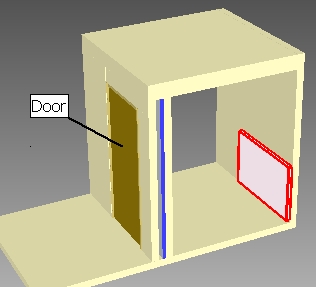
The resulting temperature distribution in the room is:

Despite the fact this is part 7 in a series about U-Value we’ve done precious little U-value calculations. To derive the U-value for room as a whole, we need to know the amount of heat that leaves the room (= the amount of heat dissipated by the radiator), the total surface area of room, the internal room temperature and the external temperature. For this model:
U-value = 200W / (20.6 degC – 2.0 degC) x 7.9 m² = 1.36 W/m²K
Considering UK building regs stipulate a U-value of less than 0.3 W/m²K the value of 1.36 W/m²K is really bad, why? For this model we are effectively looking at only a relatively small section of a room (think of it as part of a corridor), a section that has a disproportionately large area of door in it. Compared to a 300 mm thick cavity wall, doors are really rubbish at restricting heat, it is this that is pushing up this ‘local’ U-value.
So, let’s open the door a crack, a 5mm gap to be precise. Simply a question of redefining the geometry in the model to resolve the gap between door and jam (the wall above door is hidden for clarity in this image):
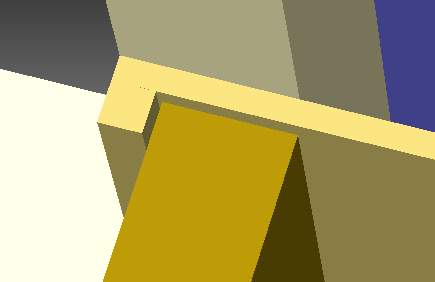
Whether the air can only enter/leave the room through the door gap or whether there is another gap somewhere else in the room that allows the air to flow right through can have a large effect on the resulting U-value. To investigate this two models are simulated, one with the room sealed apart from the door gap. The other model has a gap under another internal door leading to another room. Comparing the resulting temperature distributions for both models shows marked differences:
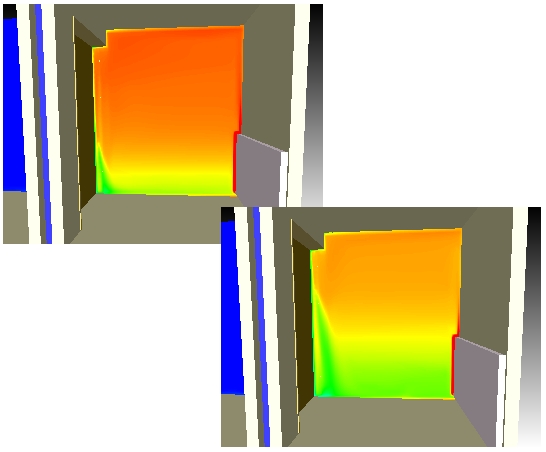
Remembering that the U-value for the room section with the door closed was 1.36 W/m²K, with a door gap but the rest of the room sealed the U-value is 1.43 W/m²K, an increase (compared to no door gap) of 5%. With an internal door gap allowing throughflow the U-value becomes 1.63 W/m²K, an increase (compared to no door gap) of 20%.
A CFD based simulation using FloVENT provides more than just the opportunity to observe temperatures. By examining air flow patterns an understanding of why the temperatures are what they are can be gleaned. A great way of understanding the airflow patterns is to animate air flow arrows, akin to introducing smoke in the door gap to visualise the subsequent convection of air passing through the gap. The animation below shows the trickling of cold air that comes in the lower portion of the door crack:
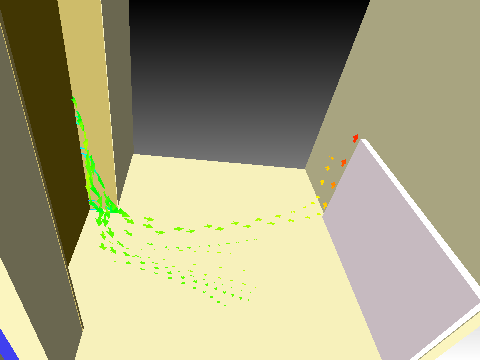
With the rest of the room sealed, any air trickling in through the gap has to be balanced by air being pushed out. The simulation predicts, as expected, that the cold air trickles in through the bottom half of the crack and warmer air trickles back out the top portion, a double whammy.
By introducing another gap under an internal door in the opposite wall a through flow of air is established. In this case air trickles in through the entire gap of the outer door, dumps down to the floor, spreads and leaves through the opposing under door gap. The overall trickle rate is much larger and dumps cold air across much more of the floor area:

Another great visualisation ‘tool’ is the ability to plot 2D planes of constant value, called ‘iso-surfaces’. The picture below shows iso-surfaces of where the air is at 14 degC, decidedly cold. The volume ‘under’ the iso-surface puddle is less than 14 degC. With a single door crack this cold puddle is somewhat restricted to the area near the door. For the double gap model this puddle volume extends over nearly all the floor surface:
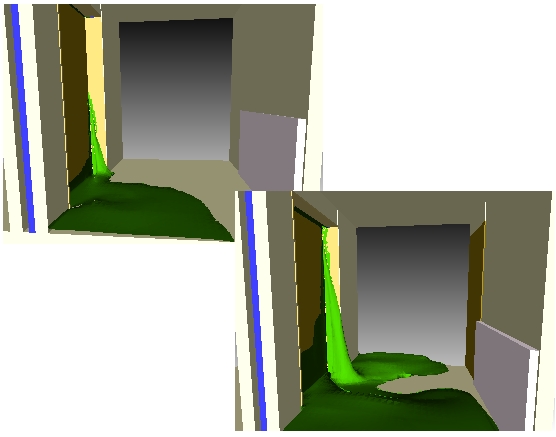
To badly corrupt an Oscar Wilde quote: “To suffer one door gap can be regarded as misfortune; to suffer two looks like carelessness”
***FREE MODEL DOWNLOAD FOR FLOVIZ***
As described in this previous post, FloVIZ is a freely available viewer to import and inspect, in real time and in 3D, the CFD simulation results from FloVENT. Below are links to the 3 models (.pack files) used in this blog. If you haven’t downloaded and installed FloVIZ already, do it now then download the models, [File/Import pack file…] and away you go 🙂
 Initial model with the closed door (Room-U-Value-with-Closed-Door.pack 22MB)
Initial model with the closed door (Room-U-Value-with-Closed-Door.pack 22MB)
 Single door crack in the outer door (Room-U-Value-with-Door-Crack.pack 33MB)
Single door crack in the outer door (Room-U-Value-with-Door-Crack.pack 33MB)
 Door crack in outer door and under inner door (Room-U-Value-with-x2-Door-Cracks.pack 40MB)
Door crack in outer door and under inner door (Room-U-Value-with-x2-Door-Cracks.pack 40MB)
Enjoy!
7th April 2010 Hampton Court

